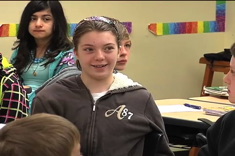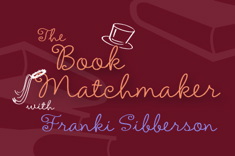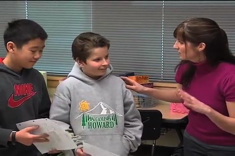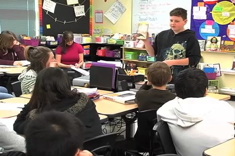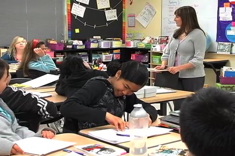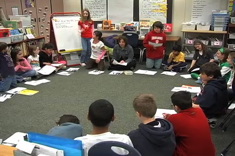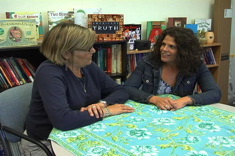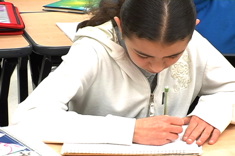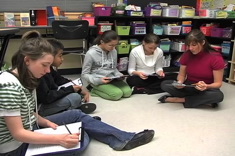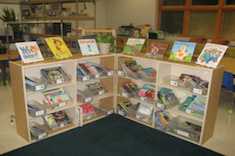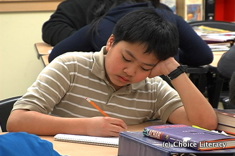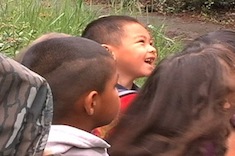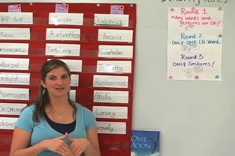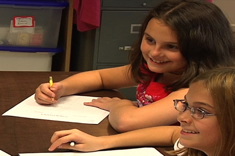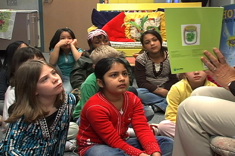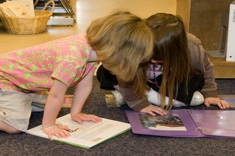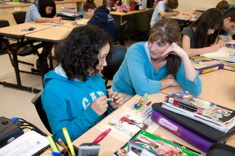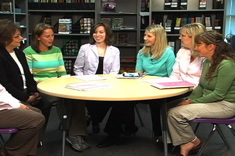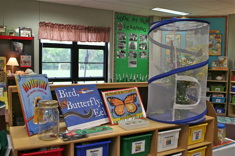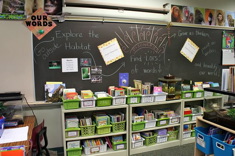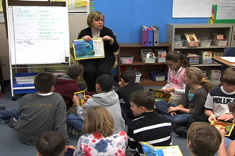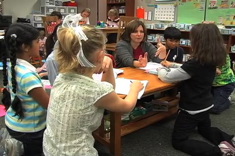Community Building
It's one of the big paradoxes of literacy instruction - students best learn how to read and write independently when they have a strong community of support in classrooms. How teachers build those thoughtful, kind, and challenging classroom communities is explained in these resources.
Latest Content
“The Wrath of Guess Jeans”: Response and Read Around
In this second video in a three-part series, Katie Doherty leads her 6th graders through a response activity. In this installment, the students respond orally and share some of their writing, making links to pop culture and other books from reading workshop.
Book Matchmaker: A Friendship Theme for Literature Circles
Franki Sibberson shares her top picks for literacy circles with a friendship theme. This is an excellent theme for building community any time of year.
Preparing for Book Talks
In this first video in a two-part series, Katie Doherty meets with her sixth-grade students who will be sharing their book recommendations with the class.
A Congenial Parent Night
Invigorate your parent night with these suggestions from Trish Prentice.
Student Book Talks
In this second video in a two-part series, Katie Doherty's sixth-grade students share their book recommendations with the class. Students work from a template provided by Katie to ensure their presentations are brief, thoughtful, and connected to reading workshop.
Seedfolks: Connecting Community and Literature
There's so much to do during the first weeks of school, but it's important not to skip the most important thing – building a sense of community with your students.
Read Alouds for the Last Days of School
Choice Literacy readers share some of their favorite read alouds for the last days of school.
Choosing 5th Grade Read Alouds for the New Year
So many wonderful choices, so little time! Karen Terlecky makes her selections for a year of 5th grade read alouds.
Literacy Keepsakes to Carry Home at the End of the School Year
Choice Literacy readers share their favorite gifts for students to make and take home at the end of the year.
From Teacher to Coach: Building Community in the Early Days
The transition from teacher to coach is tricky. Melanie Quinn has advice for building relationships with colleagues in the first weeks of school.
Writing and Publishing Book Reviews with Middle School Students
What teenager doesn't enjoy critiquing everything in the world? Erin Ocon puts that judgmental passion to good use in her classroom with a book review assignment.
Linking Reading, Writing, and Getting to Know You Activities During the First Week of Middle School
Want to get your middle school students’ attention on the first day of school? Read a book about how to ruin it for them.
What Messages Do We Give Students with Our Classroom Library Design?
Franki Sibberson describes how the topics and arrangements of baskets in the classroom library give strong messages about reading to students.
“This Could Be Our Family”: Books for Children with Lesbian and Gay Parents
Andie Cunningham considers the diversity in how “families” are defined in children’s literature, as well as how some newer books can support children with lesbian or gay parents in our new booklist.
Dear Mrs. T: Moving Students from Summaries to Rich Response
Karen Terlecky shares how student letter writing about books has evolved over the years. The secret? Karen uses student letters from previous years as mentor texts for moving her 5th graders from summaries to more sophisticated responses.
From Page to Screen: My Top Ten Film Adaptations of Children’s Books
Shari Frost is inspired to create a list of her favorite children’s book to film adaptations.
Making a Difference: Examples from Children’s Literature (BOOKLIST)
Spring is a time in many schools for volunteer work and community service projects. This booklist will inspire your students.
Vocabrity: Fun with Words for Middle School Students
Are your students getting bored with vocabulary routines? Katie Doherty invents a quick and fun game, Vocabrity, to help her middle school students learn words.
Using Summer Reading to Expand the Whole School Reading Community
What big messages do we give to students with summer reading assignments? Franki Sibberson considers this question and shares the template she sends home with children of all ages.
The Joy of Letter Writing: An Integrated Unit for Intermediate Students
Letter writing isn't a lost art in Mary Lee Hahn's 4th grade classroom. This unit has timeless appeal for students of all ages.
Books That Invite Thoughtful Conversation in Grades K-2
Nothing beats an engaging and fun text to spark conversations among young children. Here are some suggestions of terrific read-alouds to get the chatter started in classrooms.
Where Am I?: The Power of Wordless Photo Books for Preschoolers
Melissa Kolb shares the power of wordless photo books with preschoolers, explaining how they work in her classroom and demonstrating with a video.
The Book Lovers Quilt Project
Katie Doherty and Ruth Shagoury present a fun way to launch (or close) the year with middle schoolers and discover the best-loved books of students from previous years. This project can be adapted for any age level.
Creating a Culture of Literacy
How do we create schools and communities where everyone is passionate about reading and writing? Shari Frost has practical advice for teachers and school leaders.
Our Daily Question: Building a Community Through the Data We Collect
If you’re looking for routines that meld community building and learning essential skills, you might enjoy Andrea Smith’s “Our Daily Question” activity with her 3rd and 4th grade students. Classmates share interests and build data gathering and analysis skills together.
Living Words: Integrating Word Study, Technology, and Content Literacy (Part 1)
Living Words is a quick routine from Andrea Smith that helps students see the power of rich vocabulary for describing the natural world around them.
Thinking About 5th Grade Read Alouds
Karen Terlecky develops a plan for read alouds with her 5th grade students. She explains her choices, comparing selections to last year's list.
Creating a Model Writing School
Julie Johnson shares the professional development plan and experiences that led to her school's evolution into a model writing school.
Eight Tips for Building Relationships: A Tale of Two Literacy Coaches
Shari Frost presents a tale of two literacy coaches – one who has had success building close relationships with colleagues, and one who has struggled. In analyzing their experiences, she presents eight practical strategies for building relationships over time.
Books that Invite Student Participation
Franki Sibberson has suggestions for read-alouds that encourage kids to participate.
Browse Content By
Type
Category
- Assessment Tools
- Big Fresh Archives
- Booklists
- Choice Numeracy
- Classroom Design
- Common Core
- Community Building
- Conferring
- Content Literacy
- Digital Literacy
- English Language Learners
- Equity
- Family Relations
- Free Samples
- Guiding Groups
- Leadership
- Literacy Coaches
- Mentor Texts
- Minilessons
- New Teacher Mentors
- Podcasts
- Poetry
- Quote Collections
- Reading Strategies
- Self Care
- Struggling and Striving Learners
- Talking and Listening
- Teacher Study Groups
- Teaching Reading
- Teaching Writing
- Word Study and Vocabulary
Author
- Melissa Quimby
- Nawal Qarooni
- Gwen Blumberg
- Julie Cox
- The Lead Learners
- Hannah Tills
- Josie Stewart
- Ruth Metcalfe
- Mallory Messenger
- Becca Burk
- Jodie Bailey
- Vivian Chen
- Mary Brower
- Tiffany Abbott Fuller
- Stephanie Affinito
- Ruth Ayres
- Leigh Anne Eck
- Heather Fisher
- Shari Frost
- Julie Johnson
- Suzy Kaback
- Gigi McAllister
- Shirl McPhillips
- Melanie Meehan
- Cathy Mere
- Debbie Miller
- Tara Barnett and Kate Mills
- Tammy Mulligan
- Dana Murphy
- Bitsy Parks
- David Pittman
- Brenda Power
- Heather Rader
- Matt Renwick
- Mandy Robek
- Christy Rush-Levine
- Gretchen Schroeder
- Jen Schwanke
- Brian Sepe
- Katherine Sokolowski
- Stella Villalba
- Jennifer Vincent
Grade Level
Choice Literacy Membership
Articles
Get full access to all Choice Literacy article content
Videos
Get full access to all Choice Literacy video content
Courses
Access Choice Literacy course curriculum and training

